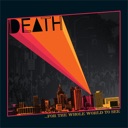Punk & Alt-Rock
Bad Brains
Photograph by Entertainment PicturesKey Attributes of Punk & Alt-Rock
Select to filter timelineThemes
- Economics/Poverty
- War
- Civil Rights
- Racism/Discrimination
- Futurism
- Nightlife/Parties
- Political Issues/Activism
Musical Features
- Rhythms
- Timbre
Instruments
- Bass
- Drums
- Electric Guitar
- Voice
“Rock ‘n’ Roll is Black music and we are its heirs.”Greg Tate & Vernon Reidfrom the Black Rock Coalition manifesto
Punk and alt-rock are sub-genres of rock. Although they became commonly understood as musical idioms predominantly performed by and narrowly marketed to young white males, Black rockers contributed to their development. In the late-1960s, rockers in Detroit and New York created proto-punk out of a desire to remove the sonic excesses and eliminate the freestyle approach associated with the hard-edge psychedelic rock style of Jimi Hendrix. Alt-rock (alternative rock) emerges from independent music scenes, dissenting from corporate and mainstream trends, and does not represent one genre. Punk and alt-rock represents a do-it-yourself ideology and an aesthetic approach that expresses rebellion and alienation.
Context and History
Late 1960s through the Mid-1970s: Proto-Punk
The 1960s was an era of social unrest stemming from multiple and overlapping protest movements: Civil Rights, anti-Vietnam War, and Women’s Liberation. In the late-1960s through the early 1970s, in Detroit and New York City, the proto-punk bands MC5, Stooges, Alice Cooper, New York Dolls, and The Velvet Underground were creating new sounds. The music was more aggressive than that of their rock contemporaries and the lyrics often had anti-authoritarian themes. Forgoing the non-structured approach, they revived the basic three chords and simple melodies of the 1950s and early 1960s rock ‘n’ roll music that they played loud and at a faster tempo.
These sounds, lyrical themes, and the live theatrical performance aesthetic resonated with and inspired a few Black rockers, who became a part of the proto-punk scene. The brothers Bobby, David and Dannis Hackney formed one of the early proto-punk bands in 1973, naming the band Death. Growing up in Detroit, the band’s musical taste was eclectic. They were attracted to the rhythms of Detroit’s industrial sounds as well as the sounds of R&B, gospel, soul, funk, Motown, reggae, Alice Cooper, and the rock touring groups performing and recording in Detroit such as The Who and the Rolling Stones. Operating outside the white, proto-punk underground scene in the city, Death created a unique, hard-rocking aggressive sound characterized by complex rhythmic structures, percussive vocal timbres, varying instrumental qualities and tinges of rhythm and blues.
After refusing a record deal offered by Columbia Records’s Clive Davis, because Davis wanted them to change their name, Death founded the Tryangle label. They pressed their own records but couldn’t secure radio air play. Disco was in vogue and the control of playlists by local disc jockeys was shifting to corporate consultants. Death disbanded in 1977. The rediscovery and 2009 release of the band’s demos recorded in the mid-70s led to their resurgence and deserved recognition as a pioneering proto-punk band. The band began touring worldwide in 2010, and the Hackney brothers were the subject of the documentary A Band Called Death (2012). Since Death’s re-discovery, Drag City Records and Tryangle Records have released three compilation albums, four singles, and an LP of old and new material N.E.W. (2015).
In the mid-1970s, New York City became the center for the underground proto-punk scene. Unlike Death in Detroit, the all-Black band Pure Hell was a part of this white scene with the Dictators, Patti Smith, and Richard Hell & the Voidoids on this scene. Inspired by Iggy & the Stooges, Alice Cooper, and Jimi Hendrix, Pure Hell formed in 1974 in Philadelphia and later moved to New York. Their sound has been described as “louder, faster and more provocative than even those artists’ most experimental records” (“Noise Addiction” and “I Feel Bad” 1978).
The band also became known for its unusual fashion (wigs and high heels) and spectacular stage act full of gymnastic theatrics. Despite successful performances in New York City and during European tours, Pure Hell experienced racism. Similar to the experiences of Death, record labels wanted them to change their name and style of music to conform to racial stereotypes. Refusing to comply, the band lost record deals, performance opportunities and momentum. By 1980, Pure Hell faded from the scene. The discovery of the band’s master tapes, recorded in 1979 and released in 2006, revived their legacy as an innovative pioneering proto-punk band.
In the UK, early punk progenerated new wave and alt-rock, and was never a whites-only affair. Black and mixed-race musicians were part of the scene since the beginning, such as Poly Styrene of the punk X-Ray Spex (“Oh Bondage Up Yours,” 1977), and the Black British reggae-punk pioneer fusion group Basement 5 (“Riot,” 1980) that featured the legendary Black British filmmaker Don Letts on vocals. Additional musicians include, Pauline Black of the new wave 2 Tone ska revival band The Selecter (“Three Minute Hero,” 1980), and Burmese born Annabella Lwin, who fronted the new wave group Bow Wow Wow, (C-30 C-60 C-90 Go!, 1980).
In the States a free-jazz-punk-funk movement emerged and kicked off James White and The Blacks’ “Stained Sheets” (1978) and “Contort Yourself/(Tropical) Heatwave” (1979) that spawned trombonist Joe Bowies/Defunct’s “Eraserhead” (1988), whose early incarnation featured Living Colour’s Vernon Reid and bassist Melvin Gibbs. They later formed the Black Rock Coalition flagship affiliated band, and Epic Recording act Eye & I Gibbs.
In the 1980s and into the 21st century, descendants of Black Rock progenitors appeared on the charts. They include: the metal group Living Colour (Vivid, 1988), the rap-metal fusion band Rage Against The Machine (Rage Against The Machine, 1992), the eclectic, alt-rockers Fishbone (The Reality of My Surroundings, 1991), the punk group Bad Brains (Build A Nation, 2007) and heterogeneous, genre-bending performer Janelle Monáe (The Arch Android, 2013).
In the 1980s and 1990s, Black rockers were blurring genres in the production of new hybrid and eclectic styles identified as alt-rock and post-punk.
The 1980s-1990s: Hardcore Punk, Metal, and Alt-Rock
The 1980s witnessed the rise of Rick James (Street Songs, 1981) and Prince (Purple Rain, 1984), both of whom contributed major chart busters to the Black rock canon. Especially noteworthy are James’s “Give It to Me Baby” and “Superfreak” and Prince’s, “Let’s Go Crazy,” “Darling Nikki,” and “The Beautiful Ones.” In the 1980s and early 1990s their mantle was taken up by three Black rock bands with all-Black membership—Bad Brains, Fishbone, and Living Colour.
These bands drew upon a broad range of multi-genre influences across the board of modern pop—heavy metal, funk reggae, hip-hop, Afrobeat, ska, and punk. They also were enthralled by the jazz-funk fusion of ’70s Miles Davis and his musical progeny Herbie Hancock, Tony Williams Lifetime, Weather Report, Mahavishnu Orchestra, Billy Cobham, and Return to Forever. The influences of these jazz-fusion groups as well as their blend of elements from multi-genres fused with their own innovations are heard in: Bad Brains’ “Banned In DC” (1982), “I Against I” (1986), and “With The Quickness” (1988); Fishbone’s “Party At Ground Zero” (1985), “Ma and Pa” (1988), their amped-up cover of Curtis Mayfield’s “Freddie’s Dead” (1988), “Everyday Sunshine” (1991), and, “Black Flowers” (1993); and Living Colour’s “Cult of Personality” (1988) and “Time’s Up” (1990). These songs won Living Colour Grammys in 1990 and 1991 respectively.
In 1985 Vernon Reid, founder and lead guitarist for Living Colour, instigated the creation of the Black Rock Coalition (BRC). This anti-racist support organization for the contemporary Black Rock community of musicians and devotees continues to thrive today. Early members of the BRC included the South Bronx-born quartet (then trio, now quartet again) 24-7 Spyz, whose albums Harder Than You (1989), Gumbo Millennium Strength In Numbers (1992), and Temporarily Disconnected (1995) garnered them cult support in Europe. This audience has given 24-7 Spyz a core tour base that has sustained them to the present-day while the mainstream American market success experienced by Living Colour has eluded them.
A notable multi-ethnic rap-metal-fusion band, Rage Against the Machine (RATM), formed in 1991 in Los Angeles by Black guitarist Tom Morello and Chicano lead singer Zach De La Rocha. The band carried the Black Rock charge forward via Morello’s innovative guitar emulations of Public Enemy’s Bomb Squad productions and De La Rocha’s vocal fusing of punk intensity and rap flow. With the albums Rage Against the Machine, Evil Empire and The Battle For Los Angeles, RATM grew a loyal fan base that lead to them selling 16 million albums worldwide by 2010 despite breaking up in 1999. Another example of a rap-metal fusion is Body Count founded by rapper Ice T and guitarist Ernie C. Similar to RATM’s politically revolutionary musical vision, Body Count produced the controversial anti-police violence protest song, “Cop Killer” (1992).
In Atlanta, Follow for Now formed in 1987 and left behind a legacy of headlining major venues with no album. Their first self-titled album released in 1991 received positive reviews from Rolling Stone magazine. The 2000s saw the advent of TV On the Radio, who emerged as the only predominantly Black rock band from Brooklyn’s thriving alt-rock scene. Spin magazine named the group’s second album, Return to Cookie Mountain (2006), its album of the year.
The 2000s: Afro-Punk
NYC’s Black Rock and hardcore punk scene of the late-1990s and early-2000s provoked the creation of a plethora of underground Black bands that rocked a genre defined as “hardcore:” Funkface, Sophia’s Toy, Tamar-Kali (who coined her own genre, Geechee Goddess Hardcore Warrior Soul), Honeychile, and Maya. The latter three women started a mini-festival series called Sista Grrrl Riots that recurred at the legendary rock club CBGBs in the late ’90s and early 2000s.
Members of Funkface, Tamar-Kali and Honeychile prominently appear in James Spooner’s Afropunk (2003) documentary who, along with others, describe their experiences in a mostly white sub-culture. This documentary led to the establishment in 2005 of an annual Afropunk Festival that has been franchised from Brooklyn to satellite fests in Atlanta, Paris, and Dakar. The Afropunk events have featured vintage and contemporary Black rock acts including Living Colour, Bad Brains, Fishbone, Saul Williams, Jada Pinkett Smith’s Wicked Wisdom, Janelle Monáe, Lenny Kravitz, Grace Jones, The Veldt, Ho99o9, and Death Grips, whose signature blend of noisy samples, ferocious live drumming and the hyperkinetic vocals of MC Ride come off as bent on picking up were Bad Brains, Public Enemy, and Rage Against The Machine left off (DG’s dissonant mélange also manifests as a dominant, appropriated and abrasive presence on Kanye West’s 2013 Yeezus).
One of the most innovative contemporary artists is Janelle Monáe, whose creativity crosses and fuses R&B, soul, funk, hip-hop, and punk genres. Her four innovative albums Metropolis Suite, (2008), The Arch Android (2010), Electric Lady (2013), and Dirty Computer (2018) and dynamic live shows (way more metal guitar-friendly than her recordings), have established her as a genre-jumping Afrofuturist/LGBTQ feminist successor to Living Colour.
In September 2019, The Black Rock Coalition Orchestra, fast approaching their thirty-fifth year of operation, brought a history of Black rock lineage program to The Metropolitan Museum of Art, which featured Stew and a younger cool-carrier of the Black Rock flame Fantastico Negrito alongside longtime BRC mainstays Sophia Ramos, Toshi Reagon, and The Family Stand, whose 1991 album Moon In Scorpio stands toe-to-toe with the best work by Fishbone, Living Colour, and Bad Brains as a signpost of the genres ongoing devotion to soul roots, multi-genre conceptualism and virtuosic instrumental prowess.
Musical Features/Performance Style
Played at faster tempos and loud, punk draws from the basic three chords and simple melodies of the 1950s and early 1960s rock ‘n’ roll music. Post-punk embraced an Avant Garde approach to ’70s punk style. It opened the door for new wave (a synth-heavy, pop-oriented modern style) and alt-rock, a descendant of punk rock that moved away from the conventions of pop and rock. Hardcore punk was harder, faster, and more abrasive.
A new generation of Black rock bands emerged in the 1980s—Bad Brains, Fishbone, and Living Colour. Each featured virtuoso musicians proficient in any style, and singers who could scream and holler over loud guitars like glory-zapped holy rollers. They also made a point of exposing their roots by doing edgy guitar-centric covers of ’70s soul classics: Bad Brains reworking Graham Central Station’s “Hair;” Living Colour rendering a driving metal treatment of Al Green’s “Love and Happiness;” Fishbone revving up Curtis Mayfield’s “Freddy’s Dead;” Rage Against The Machine drawing from the buzzbomb sound and political fervor of Public Enemy; the dreamy soul psychedelia of The Veldt taking cues from Curtis Mayfield and Britain’s Cocteau Twins; TV On The Radio mashing up tangents drawn from acts as disparate as the Beach Boys, Talking Heads, and Pink Floyd into a hallucinatory hybrid; Janelle Monáe freely referencing film soundtracks, Hendrix, and Michael Jackson, and drawing from mélange of rave-dance electronica and acid-seared funk ‘n’ roll. Veteran singer-songwriter outliers such as Nona Hendryx, Tracey Chapman, and Marc Anthony Thompson help complete our panoramic jigsaw puzzle picture of the wily diverse Black Rock field.
Lyrics
Although rock might symbolize or be associated with youthful rebellion and resistance, mainstream rockers usually are concerned with maintaining their broad fan base, thereby, avoid singing directly about politics. On the other hand, punk and alt-rock bands are drawn to the subversive and transgressive power and the political potential feared by commercial rock stars. Their lyrics cover many topics of the human experience: social and political commentary with themes of police brutality, drug use, racism, poverty, government corruption, class/social inequality, and mental health.
Bibliography
- Henderson, David. ‘Scuse Me While I Kiss the Sky: Jimi Hendrix VooDoo Child. Atria Books; expanded edition 2006 [1978].
- Mahon, Maureen. Right to Rock. Duke University Press, 2004.















